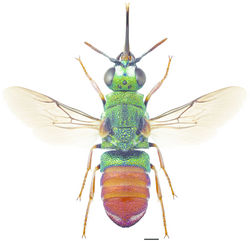Parnopes
| Notice: | This page is derived from the original publication listed below, whose author(s) should always be credited. Further contributors may edit and improve the content of this page and, consequently, need to be credited as well (see page history). Any assessment of factual correctness requires a careful review of the original article as well as of subsequent contributions.
If you are uncertain whether your planned contribution is correct or not, we suggest that you use the associated discussion page instead of editing the page directly. This page should be cited as follows (rationale):
Citation formats to copy and paste
BibTeX: @article{Paukkunen2015ZooKeys, RIS/ Endnote: TY - JOUR Wikipedia/ Citizendium: <ref name="Paukkunen2015ZooKeys">{{Citation See also the citation download page at the journal. |
Ordo: Hymenoptera
Familia: Chrysididae
Name
Parnopes Latreille, 1797 – Wikispecies link – Pensoft Profile
- Parnopes Latreille, 1797: 126.
Note
The genus can be distinguished from other genera of Parnopini by the reduced palpi, the large metascutellar projection and the larger body size. Members of the genus are parasites of ground-nesting solitary wasps of the tribe Bembicini (Crabronidae: Bembicinae). A total of 16 species are recognised, most of which occur in the Palearctic and Nearctic Regions (with 4 and 7 species, respectively) (Kimsey and Bohart 1991[1]). A few species are known from India and Africa. Only one species, Parnopes grandior, is found in Europe (Rosa and Soon 2012[2]). The genus has been divided into species-groups by Kimsey and Bohart (1991)[1].
Taxon Treatment
- Paukkunen, J; Berg, A; Soon, V; Ødegaard, F; Rosa, P; 2015: An illustrated key to the cuckoo wasps (Hymenoptera, Chrysididae) of the Nordic and Baltic countries, with description of a new species ZooKeys, (548): 1-116. doi
Images
|
Other References
- ↑ 1.0 1.1 Kimsey L, Bohart R (1991) [1990] The Chrysidid Wasps of the World. Oxford Press, New York, 652 pp.
- ↑ Rosa P, Soon V (2012) Fauna Europaea: Chrysididae. In: Mitroiu M (Ed.) Fauna Europaea: Hymenoptera, version 2.5. http://www.faunaeur.org [accessed 1 April 2015]
